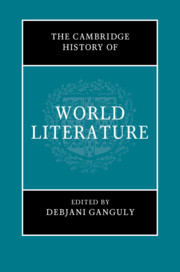Book contents
- The Cambridge History of World Literature
- The Cambridge History of World Literature
- Copyright page
- Contents
- Figures
- Contributors
- Acknowledgements
- Introduction
- Part I Genealogies
- Part II Thinking the World
- Part III Transregional Worlding
- Part IV Cartographic Shifts
- 22 The Multilingual Local: Worlding Literature in India
- 23 Oceanic Comparativism and World Literature
- 24 Mediterranean Worlds in the Long Nineteenth Century
- 25 Antipodal Turns: Antipodean Americas and the Hemispheric Shift
- 26 The Region as an In-between Space: Tomas Tranströmer’s Östersjöar and the Making of an Archipelagic Nordic Literature
- Part V World Literature and Translation
- Part VI Poetics, Genre, Intermediality
- Part VII Scales, Polysystems, Canons
- Part VIII Modes of Reading and Circulation
- Part IX The Worldly and the Planetary
- Index
- References
22 - The Multilingual Local: Worlding Literature in India
from Part IV - Cartographic Shifts
Published online by Cambridge University Press: 17 August 2021
- The Cambridge History of World Literature
- The Cambridge History of World Literature
- Copyright page
- Contents
- Figures
- Contributors
- Acknowledgements
- Introduction
- Part I Genealogies
- Part II Thinking the World
- Part III Transregional Worlding
- Part IV Cartographic Shifts
- 22 The Multilingual Local: Worlding Literature in India
- 23 Oceanic Comparativism and World Literature
- 24 Mediterranean Worlds in the Long Nineteenth Century
- 25 Antipodal Turns: Antipodean Americas and the Hemispheric Shift
- 26 The Region as an In-between Space: Tomas Tranströmer’s Östersjöar and the Making of an Archipelagic Nordic Literature
- Part V World Literature and Translation
- Part VI Poetics, Genre, Intermediality
- Part VII Scales, Polysystems, Canons
- Part VIII Modes of Reading and Circulation
- Part IX The Worldly and the Planetary
- Index
- References
Summary
Literary history in South Asia can be neither simply national nor monolingual. Its multilingualism has implications for doing world literature from a South Asian perspective, which does not follow a neat process of distillation from local to regional to national to world. Rather, it requires us to consider multiple co-existing languages (“multilingual locals”) and multiple levels and circuits of circulation that change over time in response to political, ideological, and aesthetic shifts. Paying attention to the media through which literature has circulated into and out of Indian languages, English included, and across regions and countries (“significant geographies”) is also important. We then are able to consider the relative visibility and familiarity of Indian and world literature, “thick” and “thin” readerly encounters, and the local production of world literature in new and interesting ways.
- Type
- Chapter
- Information
- The Cambridge History of World Literature , pp. 411 - 428Publisher: Cambridge University PressPrint publication year: 2021



